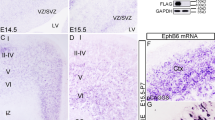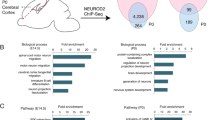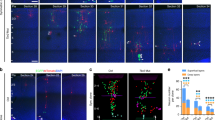Abstract
Disrupted cortical neuronal migration is associated with epileptic seizures and developmental delay. However, the molecular mechanism by which disruptions of early cortical development result in neurological symptoms is poorly understood. Here we report α2-chimaerin as a key regulator of cortical neuronal migration and function. In utero suppression of α2-chimaerin arrested neuronal migration at the multipolar stage, leading to accumulation of ectopic neurons in the subcortical region. Mice with such migration defects showed an imbalance between excitation and inhibition in local cortical circuitry and greater susceptibility to convulsant-induced seizures. We further show that α2-chimaerin regulates bipolar transition and neuronal migration through modulating the activity of CRMP-2, a microtubule-associated protein. These findings establish a new α2-chimaerin-dependent mechanism underlying neuronal migration and proper functioning of the cerebral cortex and provide insights into the pathogenesis of seizure-related neurodevelopmental disorders.
This is a preview of subscription content, access via your institution
Access options
Subscribe to this journal
Receive 12 print issues and online access
$209.00 per year
only $17.42 per issue
Buy this article
- Purchase on Springer Link
- Instant access to full article PDF
Prices may be subject to local taxes which are calculated during checkout







Similar content being viewed by others
References
Guerrini, R., Sicca, F. & Parmeggiani, L. Epilepsy and malformations of the cerebral cortex. Epileptic Disord. 5 (suppl. 2), S9–S26 (2003).
Chang, B.S. & Walsh, C.A. The genetic basis of human cerebral cortical malformations. in Principles of Molecular Medicine Vol. XIII (eds. Runge, M.S. and Patterson, C.) 1073–1079 (Humana, 2006).
Ayala, R., Shu, T. & Tsai, L.H. Trekking across the brain: the journey of neuronal migration. Cell 128, 29–43 (2007).
Valiente, M. & Marin, O. Neuronal migration mechanisms in development and disease. Curr. Opin. Neurobiol. 20, 68–78 (2010).
Gleeson, J.G. & Walsh, C.A. Neuronal migration disorders: from genetic diseases to developmental mechanisms. Trends Neurosci. 23, 352–359 (2000).
Deutsch, S.I., Burket, J.A. & Katz, E. Does subtle disturbance of neuronal migration contribute to schizophrenia and other neurodevelopmental disorders? Potential genetic mechanisms with possible treatment implications. Eur. Neuropsychopharmacol. 20, 281–287 (2010).
Singh, K.K. et al. Dixdc1 is a critical regulator of DISC1 and embryonic cortical development. Neuron 67, 33–48 (2010).
Wegiel, J. et al. The neuropathology of autism: defects of neurogenesis and neuronal migration, and dysplastic changes. Acta Neuropathol. 119, 755–770 (2010).
Nadarajah, B., Alifragis, P., Wong, R.O. & Parnavelas, J.G. Neuronal migration in the developing cerebral cortex: observations based on real-time imaging. Cereb. Cortex 13, 607–611 (2003).
Noctor, S.C., Martinez-Cerdeno, V., Ivic, L. & Kriegstein, A.R. Cortical neurons arise in symmetric and asymmetric division zones and migrate through specific phases. Nat. Neurosci. 7, 136–144 (2004).
LoTurco, J.J. & Bai, J. The multipolar stage and disruptions in neuronal migration. Trends Neurosci. 29, 407–413 (2006).
Tabata, H. & Nakajima, K. Multipolar migration: the third mode of radial neuronal migration in the developing cerebral cortex. J. Neurosci. 23, 9996–10001 (2003).
Kawauchi, T. & Hoshino, M. Molecular pathways regulating cytoskeletal organization and morphological changes in migrating neurons. Dev. Neurosci. 30, 36–46 (2008).
Hall, C. et al. alpha2-chimaerin, a Cdc42/Rac1 regulator, is selectively expressed in the rat embryonic nervous system and is involved in neuritogenesis in N1E–115 neuroblastoma cells. J. Neurosci. 21, 5191–5202 (2001).
Iwasato, T. et al. Rac-GAP alpha-chimerin regulates motor-circuit formation as a key mediator of EphrinB3/EphA4 forward signaling. Cell 130, 742–753 (2007).
Beg, A.A., Sommer, J.E., Martin, J.H. & Scheiffele, P. alpha2-Chimaerin is an essential EphA4 effector in the assembly of neuronal locomotor circuits. Neuron 55, 768–778 (2007).
Wegmeyer, H. et al. EphA4-dependent axon guidance is mediated by the RacGAP alpha2-chimaerin. Neuron 55, 756–767 (2007).
Shi, L. et al. Alpha2-chimaerin interacts with EphA4 and regulates EphA4-dependent growth cone collapse. Proc. Natl. Acad. Sci. USA 104, 16347–16352 (2007).
Miyake, N. et al. Human CHN1 mutations hyperactivate alpha2-chimaerin and cause Duane's retraction syndrome. Science 321, 839–843 (2008).
Bacchelli, E. et al. Screening of nine candidate genes for autism on chromosome 2q reveals rare nonsynonymous variants in the cAMP-GEFII gene. Mol. Psychiatry 8, 916–924 (2003).
Lencz, T. et al. Runs of homozygosity reveal highly penetrant recessive loci in schizophrenia. Proc. Natl. Acad. Sci. USA 104, 19942–19947 (2007).
Davidsson, J., Collin, A., Olsson, M.E., Lundgren, J. & Soller, M. Deletion of the SCN gene cluster on 2q24.4 is associated with severe epilepsy: an array-based genotype-phenotype correlation and a comprehensive review of previously published cases. Epilepsy Res. 81, 69–79 (2008).
Jacobs, K.M., Kharazia, V.N. & Prince, D.A. Mechanisms underlying epileptogenesis in cortical malformations. Epilepsy Res. 36, 165–188 (1999).
Ackman, J.B. et al. Abnormal network activity in a targeted genetic model of human double cortex. J. Neurosci. 29, 313–327 (2009).
Manent, J.B., Wang, Y., Chang, Y., Paramasivam, M. & LoTurco, J.J. Dcx reexpression reduces subcortical band heterotopia and seizure threshold in an animal model of neuronal migration disorder. Nat. Med. 15, 84–90 (2009).
Hall, C., Lim, L. & Leung, T. C1, see them all. Trends Biochem. Sci. 30, 169–171 (2005).
North, H.A. et al. Promotion of proliferation in the developing cerebral cortex by EphA4 forward signaling. Development 136, 2467–2476 (2009).
Torii, M., Hashimoto-Torii, K., Levitt, P. & Rakic, P. Integration of neuronal clones in the radial cortical columns by EphA and ephrin-A signalling. Nature 461, 524–528 (2009).
Ohmiya, M. et al. Brain-derived neurotrophic factor alters cell migration of particular progenitors in the developing mouse cerebral cortex. Neurosci. Lett. 317, 21–24 (2002).
Medina, D.L. et al. TrkB regulates neocortex formation through the Shc/PLCgamma-mediated control of neuronal migration. EMBO J. 23, 3803–3814 (2004).
Fukumitsu, H. et al. Brain-derived neurotrophic factor participates in determination of neuronal laminar fate in the developing mouse cerebral cortex. J. Neurosci. 26, 13218–13230 (2006).
Zhao, C.T. et al. PKCdelta regulates cortical radial migration by stabilizing the Cdk5 activator p35. Proc. Natl. Acad. Sci. USA 106, 21353–21358 (2009).
Fukata, Y. et al. CRMP-2 binds to tubulin heterodimers to promote microtubule assembly. Nat. Cell Biol. 4, 583–591 (2002).
Yoshimura, T. et al. GSK-3β regulates phosphorylation of CRMP-2 and neuronal polarity. Cell 120, 137–149 (2005).
Marín, O., Valiente, M., Ge, X. & Tsai, L.H. Guiding neuronal cell migrations. Cold Spring Harb. Perspect. Biol. 2, a001834 (2010).
Bai, J. et al. RNAi reveals doublecortin is required for radial migration in rat neocortex. Nat. Neurosci. 6, 1277–1283 (2003).
Tsai, J.W., Chen, Y., Kriegstein, A.R. & Vallee, R.B. LIS1 RNA interference blocks neural stem cell division, morphogenesis, and motility at multiple stages. J. Cell Biol. 170, 935–945 (2005).
Ohshima, T. et al. Cdk5 is required for multipolar-to-bipolar transition during radial neuronal migration and proper dendrite development of pyramidal neurons in the cerebral cortex. Development 134, 2273–2282 (2007).
Arimura, N., Menager, C., Fukata, Y. & Kaibuchi, K. Role of CRMP-2 in neuronal polarity. J. Neurobiol. 58, 34–47 (2004).
Brown, M. et al. Alpha2-chimaerin, cyclin-dependent kinase 5/p35, and its target collapsin response mediator protein-2 are essential components in semaphorin 3A-induced growth-cone collapse. J. Neurosci. 24, 8994–9004 (2004).
Pawson, T. Specificity in signal transduction: from phosphotyrosine-SH2 domain interactions to complex cellular systems. Cell 116, 191–203 (2004).
Bar, I., Lambert de Rouvroit, C. & Goffinet, A.M. The Reelin signaling pathway in mouse cortical development. Eur. J. Morphol. 38, 321–325 (2000).
Young-Pearse, T.L. et al. A critical function for beta-amyloid precursor protein in neuronal migration revealed by in utero RNA interference. J. Neurosci. 27, 14459–14469 (2007).
Chen, G. et al. Semaphorin-3A guides radial migration of cortical neurons during development. Nat. Neurosci. 11, 36–44 (2008).
Lapray, D. et al. Spontaneous epileptic manifestations in a DCX knockdown model of human double cortex. Cereb. Cortex 20, 2694–2701 (2010).
Thomas, E.A. et al. Antipsychotic drug treatment alters expression of mRNAs encoding lipid metabolism-related proteins. Mol. Psychiatry 8, 983–93, 950 (2003).
Lo, K.Y. et al. SLAM-associated protein as a potential negative regulator in Trk signaling. J. Biol. Chem. 280, 41744–41752 (2005).
Itoh, Y., Masuyama, N., Nakayama, K., Nakayama, K.I. & Gotoh, Y. The cyclin-dependent kinase inhibitors p57 and p27 regulate neuronal migration in the developing mouse neocortex. J. Biol. Chem. 282, 390–396 (2007).
Racine, R.J. Modification of seizure activity by electrical stimulation. II. Motor seizure. Electroencephalogr. Clin. Neurophysiol. 32, 281–294 (1972).
Fu, W.Y. et al. Cdk5 regulates EphA4-mediated dendritic spine retraction through an ephexin1-dependent mechanism. Nat. Neurosci. 10, 67–76 (2007).
Acknowledgements
We are grateful to C. Hall (University College London) for α2-chimaerin constructs, antibody and CRMP-2 constructs; K. Kaibuchi (Nagoya University Graduate School of Medicine) for pCRMP-2 (Thr514) antibody; and T. Matsuda and C.L. Cepko (Harvard Medical School) for pCAG vectors. We thank N. Brose and T. Marquardt (Max Planck Institute) for providing Chn1−/− mice. We thank K.-O. Lai and Z. Cheung for critical reading of the manuscript and members of the Ip laboratory for discussions. We also thank C. Kwong, H.W. Tsang, Y. Dai, B. Butt, T. Ye and K. Ho for technical assistance. This study was supported in part by the Research Grants Council of Hong Kong (HKUST 661007, 660808, 660610 and 660110), the Area of Excellence Scheme of the University Grants Committee (AoE/B-15/01) and the Hong Kong Jockey Club. J.P.K.I. and N.Y.I. are recipients of a Croucher Foundation Research Studentship and Croucher Foundation Senior Research Fellowship, respectively.
Author information
Authors and Affiliations
Contributions
N.Y.I. supervised the project. J.P.K.I., L.S., Y.C., W.-Y.F., A.K.Y.F. and N.Y.I. designed the experiments. J.P.K.I. and L.S. conducted the majority of experiments. J.P.K.I., L.S., Y.C., A.K.Y.F. and N.Y.I. performed the data analyses. Y.I. and Y.G. provided technical support on in utero electroporation and live-imaging experiments. J.P.K.I. and Y.I. performed live-imaging experiments. W.-H.Y. performed the electrophysiology experiments and subsequent data analyses. A.B. provided Chn1−/− mice. J.P.K.I., L.S., A.K.Y.F. and N.Y.I. wrote the manuscript.
Corresponding author
Ethics declarations
Competing interests
The authors declare no competing financial interests.
Supplementary information
Supplementary Text and Figures
Supplementary Figures 1–11 (PDF 1711 kb)
Supplementary Video 1
This movie shows the migration of neurons electroporated with pSUPER vector and GFP plasmids. Most of the neurons attained bipolar shape, underwent nuclear translocation and migrated up to the cortical plate. Images were captured every 15 min for 13 h. (MOV 606 kb)
Supplementary Video 2
This movie shows the migration of neurons electroporated with α2-chimerin shRNA and GFP plasmids. α2-chimerin knockdown neurons were unable to enter into the cortical plate, and showed local movement within the intermediate zone. Images were captured every 15 min for 13 h. (MOV 588 kb)
Supplementary Video 3
This movie shows an example of migrating neurons electroporated with pSUPER vector and GFP plasmids. The neuron extended and retracted neurites actively, and eventually formed one major leading process guiding the migration of cell body towards pial surface. Images were captured every 10 min for 7 h. (MOV 587 kb)
Supplementary Video 4
This movie shows an example of migrating neurons electroporated with α2-chimerin shRNA and GFP plasmids. The neuron showed impaired neurite dynamics and failed to form a leading process towards pial surface. Images were captured every 10 min for 7 h. (MOV 609 kb)
Rights and permissions
About this article
Cite this article
Ip, J., Shi, L., Chen, Y. et al. α2-chimaerin controls neuronal migration and functioning of the cerebral cortex through CRMP-2. Nat Neurosci 15, 39–47 (2012). https://doi.org/10.1038/nn.2972
Received:
Accepted:
Published:
Issue Date:
DOI: https://doi.org/10.1038/nn.2972
This article is cited by
-
Genome-wide detection of positive and balancing signatures of selection shared by four domesticated rainbow trout populations (Oncorhynchus mykiss)
Genetics Selection Evolution (2024)
-
Maternal sevoflurane exposure increases the epilepsy susceptibility of adolescent offspring by interrupting interneuron development
BMC Medicine (2023)
-
CXCR5 Regulates Neuronal Polarity Development and Migration in the Embryonic Stage via F-Actin Homeostasis and Results in Epilepsy-Related Behavior
Neuroscience Bulletin (2023)
-
CHN1 promotes epithelial–mesenchymal transition via the Akt/GSK-3β/Snail pathway in cervical carcinoma
Journal of Translational Medicine (2021)
-
Dysfunction of Trio GEF1 involves in excitatory/inhibitory imbalance and autism-like behaviors through regulation of interneuron migration
Molecular Psychiatry (2021)



